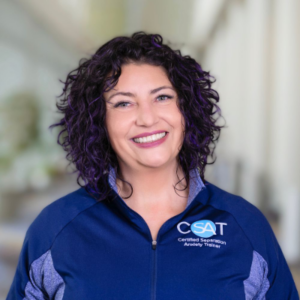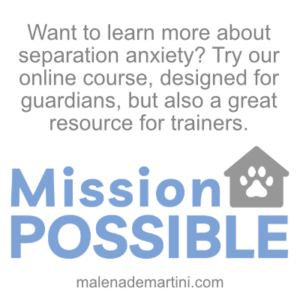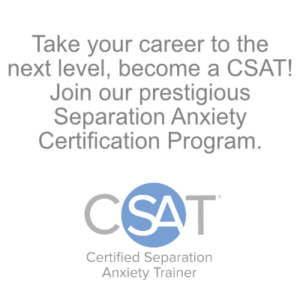Barks Blog
Malena DeMartini: A Beacon of Light for Dogs Who Suffer When Left Home Alone

Malena DeMartini shares her personal and professional journey to creating her company that provides educational programs for dog professionals and guardians to help dogs with separation anxiety.
Who are you, and what makes you passionate about animal behavior?
I have been a professional dog trainer and behavior consultant for over two decades and had a beautiful introduction to animal behavior via my education through the Academy for Dog Trainers. Initially, I worked with all manner of dog behavior, from jumpy puppies to human-directed aggression. However, I developed an early and overwhelming passion for dogs with separation anxiety (SA) after taking my first case in 2001. These dogs pull at my heartstrings, and helping them learn to be home alone without anguish is a truly rewarding experience. On top of feeling hugely rewarded by helping a dog no longer suffer, the immeasurable joy I receive from giving dog guardians their lives back is more than an added bonus.
Prior to becoming a dog professional, I had an extensive career working with statistics in the wine industry. I am grateful for my background in statistics because data tracking is essential to working with dog behavior, particularly SA. I feel strongly that the effective tracking and dissemination of data is a key element to helping a dog be safe in their own environment.
I have also walked in the shoes of the guardian of a dog with SA, which helped me recognize that support for treating SA is not only crucial for the dogs but also for their humans. It wasn’t until 10 years into my journey trying to positively modify how dogs learn to become comfortable with alone time that I stumbled across and adopted my beautiful dog, Tini. Within 24 hours of coming home, she was clearly distressed when I was not present. My experience with Tini gave me a new perspective on SA training, both the methods and the emotional experience as a guardian.
Tell us about your organization. What about your history and experiences led you to start your organization?
My organization has a variety of arms. We have the Separation Anxiety Certification Program (SACP) for dog professionals to learn to help dogs with SA. We work with dog guardians helping their dogs to overcome SA, and we support shelters and rescues in creating best practices for dogs in their care with SA. This has all been developed over the last decade; when I started, I was a sole proprietor.
When I published my first book, Treating Separation Anxiety in Dogs, in 2014, no one was applying the principles I was using in my separation cases, so I almost simultaneously launched a program to educate experienced dog professionals about how to work with dogs suffering from alone-time distress. The SACP became wildly popular, and to date, over 200 students have graduated to become Certified Separation Anxiety Trainers (CSATs).
In the nearly 10 years since launching the SACP, I have not lost my passion for working with individual dogs and their guardians. They remain the focus of what we do as an organization, both through our one-to-one training program and our online self-paced course, Mission POSSIBLE, which is designed to help dog guardians help their dogs become comfortable with alone time.
What makes your organization unique or different from other organizations?
One thing that makes our organization unique is our commitment to the process of continuous learning and growth. We are always looking to the newest research, collectively as CSATs, to improve the quality of care and welfare of individual dogs. We are committed to the highest level of professionalism and deliver the highest quality and level of training and support for dogs and their humans, which sets us apart from others.
While not a requirement, another thing that makes us unique is that many of us have walked in the shoes of the guardian of a dog with SA and can empathize with that experience and the emotional toll it can take. That shared experience with clients is often the point of connection that serves as the building block of the CSAT–client relationship.
What do you think attracts people to join your programs?
More and more, we are attracting highly skilled and educated professionals who see the systems we use and practical applications we provide throughout the SACP as broadly benefiting both their SA work and their behavior consulting work. It’s a self-selecting process; they are passionate about impacting the quality of life of dogs that experience tremendous stress when home alone. They also recognize that the principles of behavior modification can be applied across cases to positively impact a dog’s quality of life.
For guardians, I think it is our empathetic communication and timely responses to initial and follow-up inquiries, as well as our CSAT’s deep expertise and understanding of the rewards and challenges of working a training protocol from the human side, that attract them. Many prospective clients are referrals from those who have had a positive interaction with our organization.
Is there a program that you are most passionate about offering?
I am equally committed to each program we offer. My passion is even across working with and teaching dog professionals and working with and supporting dog guardians.
The SACP is an intense program that spans 14 weeks and 100+ hours of instruction. The rewards I get from seeing students having those “ah-ha” moments, learning principles that help dogs with SA and with all manner of client counseling and behavior modification, are immeasurable. Our class sizes are small, which allows us to provide a constant feedback loop with students working on progressive assignments that build upon one another and receiving individualized feedback on each one. Our goal is to set up our students for success.
I am equally passionate about helping and supporting the learning of dog guardians. They often come to us desperate, with feelings of guilt, and confused about how to help their dog. If you Google “separation anxiety,” you will find a lot of misinformation. We have a responsibility to guardians to help them understand these misconceptions and how and why working a protocol is best practice. Walking dog guardians through the training process is both incredibly rewarding and reinforcing.
Within each of the programs you offer, how do you support learning before, during, and after program completion?
In the SACP, learning begins with a copy of my second book, Separation Anxiety in Dogs: Next Generation Protocols and Practices, and access to Mission POSSIBLE. Then, the program itself runs 14 weeks with twice-weekly webinars and weekly office hours, in addition to regular homework that has students applying their learning and receiving extensive and personalized feedback on assignments. We keep a low student-to-teacher ratio to provide a high level of support and create a strong connection with students. Upon graduation, CSATs receive continued support for their learning through participation in a monthly seminar, mentorship program, and membership in our Facebook group exclusively for CSATs.

For guardians who do one-to-one training, CSATs often function not only as trainers but also as coaches, counselors, and accountability partners to their individual clients. We work in a collaborative way with clients, engaging in regular communication, writing daily customized training protocols for that dog in that environment, and tracking data unique to that dog to make criteria-setting decisions to ensure the dog’s well-being. This level of training support is unparalleled and designed to help both the dog and the guardian each step of the way.
What are some of the highlights from the last five years? What are you most proud of?
While not easy for me to express pride, I am excited about some recent accomplishments. In 2020, I published my second book, Separation Anxiety in Dogs: Next Generation Protocols and Practices, and that was an amazing experience. Data from the CSAT community contributed to its publication, and its release felt like a way to share those amazing collective discoveries from our ongoing work and learning. The book has been pivotal in influencing the industry about working with SA clients and their dogs.
I love the teaching process, and there is a sense of pride in seeing SACP graduates go on to positively impact the lives of so many clients and their dogs. With so many CSATs now creating educational resources and working with clients and their dogs, we have been able to help ensure that when guardians do an Internet search for separation anxiety, they are getting the best and right information.
What is the future for your organization?
In many ways, the future is wide open because of our organizational commitment to continuously building and refining our knowledge and skills to be able to best help dogs and the people who love them. Our passion for furthering our own education and that of the dog professionals we work with, as well as our commitment to providing the highest level of support to individual dogs and their guardians, has the possibility to take shape in many different ways as we continue to move forward.
If there was one thing you could change about the pet industry, what would it be?
I’d like to see the industry marry our high level of experience and expertise as dog behavior consultants, specifically as CSATs, with that of veterinarians and veterinary behaviorists to better support dog guardians, pet sitters—all of the people who create a separation anxiety dog’s village—as a team. This is crucial to best supporting individual dogs and their guardians.
Anything else you want to add that is unique to your organization, or unique to you?
I find so much value in the diverse personal and professional backgrounds I get to work with every day. The unique experiences that each person brings to this work only furthers our commitment to elevating professionalism in our industry. The personality and skills each CSAT brings to their work collectively shape what we are able to bring forward as an organization to best address SA. We have intentionally created an environment and a community to support CSATs’ learning and growth throughout their career, which is truly unique.
Learn more about Malena DeMartini at malenademartini.com.


